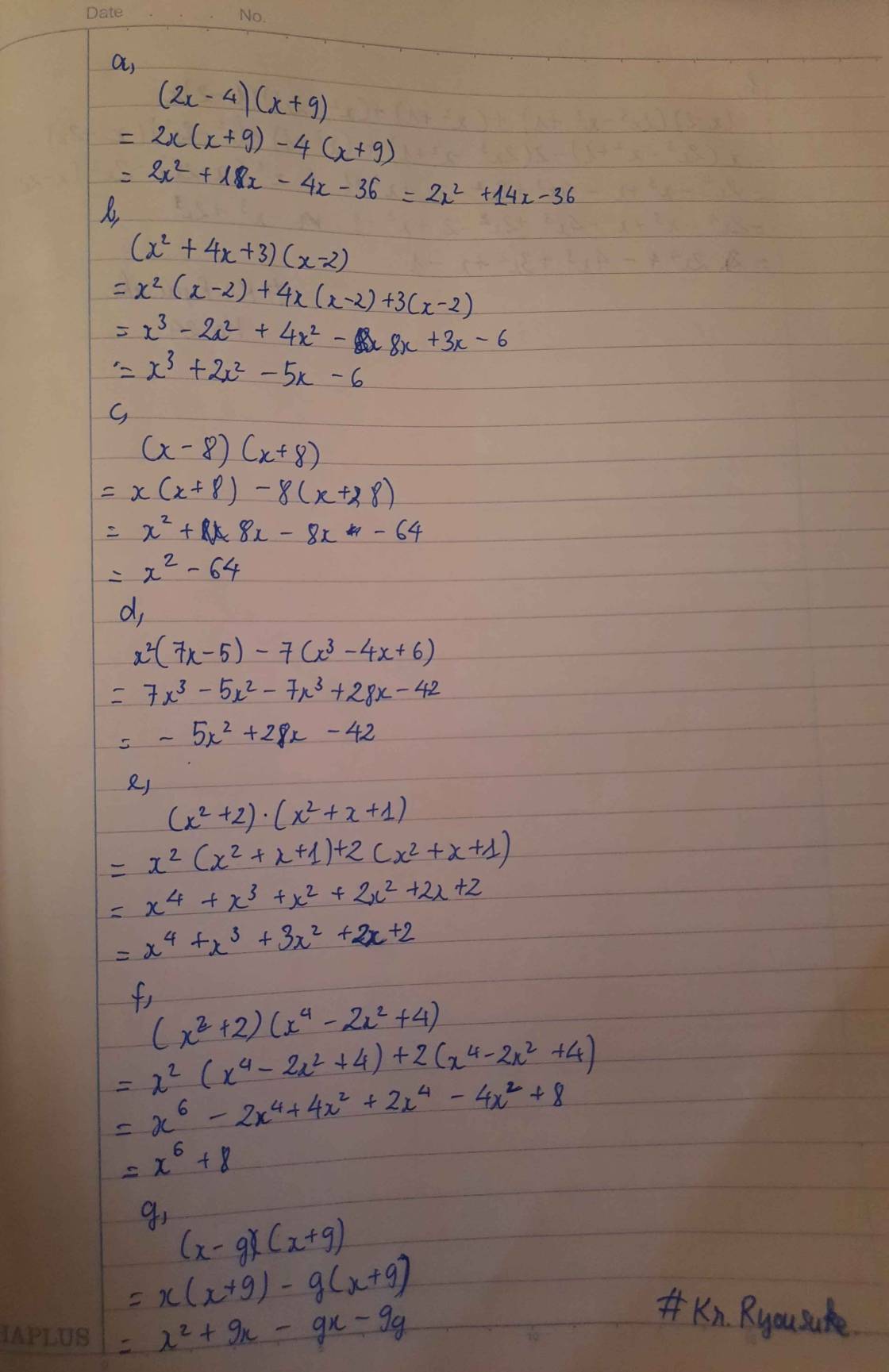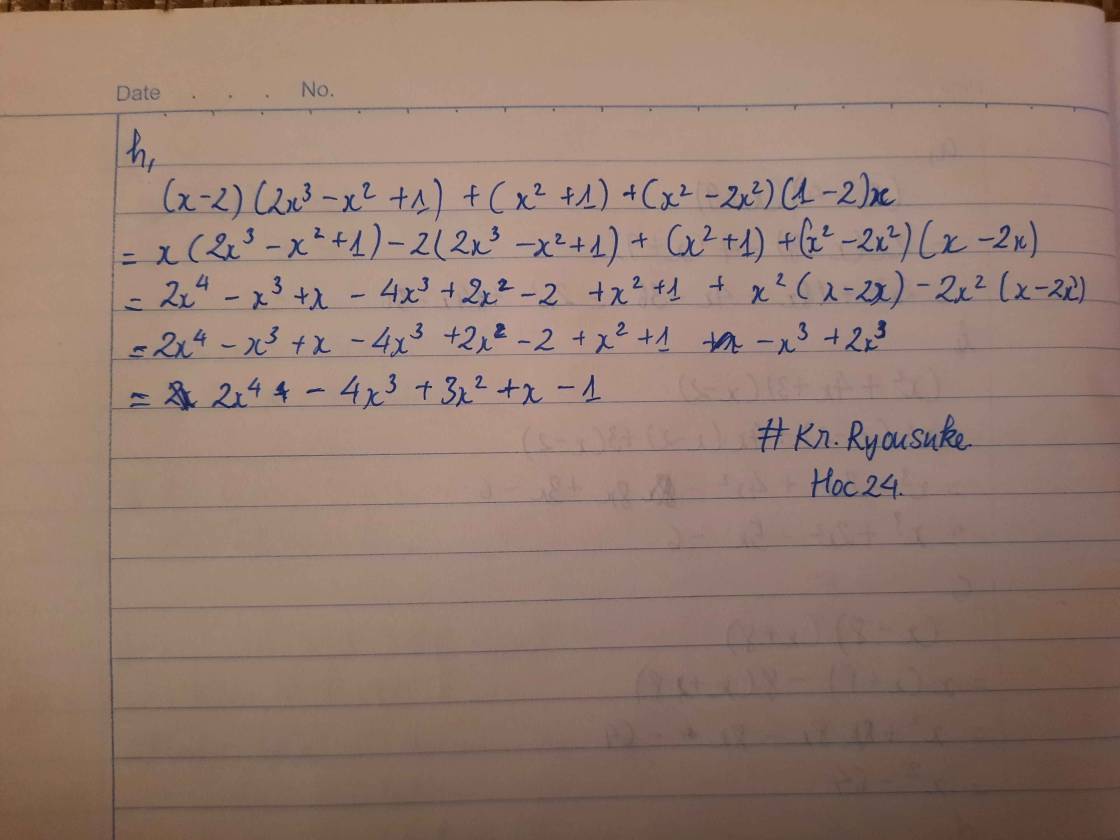
Hãy nhập câu hỏi của bạn vào đây, nếu là tài khoản VIP, bạn sẽ được ưu tiên trả lời.


Bài 1:
b: \(\dfrac{72-x}{7}=\dfrac{x-70}{9}\)
=>648-9x=7x-490
=>-16x=-1138
hay x=569/8
c: \(\Leftrightarrow x^2=\dfrac{36}{25}\)
hay \(x\in\left\{\dfrac{6}{5};-\dfrac{6}{5}\right\}\)
d: Đặt x/5=y/4=k
=>x=5k; y=4k
Ta có: xy=180
\(\Leftrightarrow20k^2=180\)
\(\Leftrightarrow k^2=9\)
Trường hợp 1: k=3
=>x=15; y=12
Trường hợp 2: k=-3
=>x=-15; y=-12

1, \(\left(2x+3\right)^2-\left(2x+1\right)\left(2x-1\right)=5\)
\(\Leftrightarrow4x^2+12x+9-4x^2-1=5\)
\(\Leftrightarrow12x=-3\)
\(\Leftrightarrow x=\dfrac{-1}{4}\)
Vậy \(x=\dfrac{-1}{4}\)
2, \(\left(x+3\right)\left(x^2-3x+9\right)-x\left(x^2+5\right)=20\)
\(\Leftrightarrow x^3+27-x^3-5x=20\)
\(\Leftrightarrow5x=7\)
\(\Leftrightarrow x=\dfrac{7}{5}\)
Vậy...
5, \(x^2-9+5\left(x+3\right)=0\)
\(\Leftrightarrow\left(x-3\right)\left(x+3\right)+5\left(x+3\right)=0\)
\(\Leftrightarrow\left(x+3\right)\left(x-3+5\right)=0\)
\(\Leftrightarrow\left(x+3\right)\left(x+2\right)=0\)
\(\Leftrightarrow\left[{}\begin{matrix}x+3=0\\x+2=0\end{matrix}\right.\Leftrightarrow\left[{}\begin{matrix}x=-3\\x=-2\end{matrix}\right.\)
Vậy...
1) \(\left(2x+3\right)^2-\left(2x+1\right)\left(2x-1\right)=5\) (1)
\(\Leftrightarrow4x^2+12x+9-\left(4x^2-1\right)=5\)
\(\Leftrightarrow4x^2+12x+9-4x^2+1=5\)
\(\Leftrightarrow12x+10=5\)
\(\Leftrightarrow12x=5-10\)
\(\Leftrightarrow12x=-5\)
\(\Leftrightarrow x=-\dfrac{5}{12}\)
Vậy tập nghiệm phương trình (1) là \(S=\left\{-\dfrac{5}{12}\right\}\)
2) \(\left(x+3\right)\left(x^2-3x+9\right)-x\left(x^2+5\right)=20\) (2)
\(\Leftrightarrow x^3+27-x^3-5x=20\)
\(\Leftrightarrow27-5x=20\)
\(\Leftrightarrow-5x=20-27\)
\(\Leftrightarrow-5x=-7\)
\(\Leftrightarrow x=\dfrac{7}{5}\)
Vậy tập nghiệm phương trình (2) là \(S=\left\{\dfrac{7}{5}\right\}\)
3) \(\left(x+2\right)^3-x\left(x^2+6x\right)=15\) (3)
\(\Leftrightarrow x^3+6x^2+12x+8-x^3-6x^2=15\)
\(\Leftrightarrow12x+8=15\)
\(\Leftrightarrow12x=15-8\)
\(\Leftrightarrow12x=7\)
\(\Leftrightarrow x=\dfrac{7}{12}\)
Vậy tập nghiệm phương trình (3) là \(S=\left\{\dfrac{7}{12}\right\}\)
4) \(\left(x-1\right)\left(x^2+x+1\right)-x\left(x+10\right)\left(x-1\right)=7\) (4)
\(\Leftrightarrow\left(x-1\right)\left(x^2+x+1-x\left(x+10\right)\right)=7\)
\(\Leftrightarrow\left(x-1\right)\left(x^2+x+1-x^2-10x\right)=7\)
\(\Leftrightarrow\left(x-1\right)\left(-9x+1\right)=7\)
\(\Leftrightarrow-9x^2+x+9x-1=7\)
\(\Leftrightarrow-9x^2+10-1=7\)
\(\Leftrightarrow-9x^2+10x-1-7=0\)
\(\Leftrightarrow-9x^2+10x-8=0\)
\(\Leftrightarrow9x^2-10x+8=0\)
\(\Leftrightarrow x\notin R\)
5) \(x^2-9+5\left(x+3\right)=0\) (5)
\(\Leftrightarrow x^2-9+5x+15=0\)
\(\Leftrightarrow x^2+5x+6=0\)
\(\Leftrightarrow\left[{}\begin{matrix}x=\dfrac{-5+1}{2}\\x=\dfrac{-5-1}{2}\end{matrix}\right.\)
\(\Leftrightarrow\left[{}\begin{matrix}x=-2\\x=-3\end{matrix}\right.\)
Vậy tập nghiệm phương trình (5) là \(S=\left\{-3;-2\right\}\)

a; (\(x\) - 2)2.(\(x+1\)).(\(x\) - 4) < 0
(\(x-2\))2 ≥ 0 ∀\(x\); \(x+1\) = 0 ⇒ \(x=-1\); \(x-4\) = 0 ⇒ \(x=4\)
Lập bảng ta có:
| \(x\) | - 1 4 |
| \(x+1\) | - 0 + | + |
| \(x-4\) | - | - 0 + |
| (\(x-2\))2 | + | + | + |
| (\(x-2\))2.(\(x+1\)).(\(x+4\)) | + 0 - 0 + |
Theo bảng trên ta có: -1 < \(x\) < 4
Vậy \(-1< x< 4\)
b; [\(x^2\).(\(x-3\)):(\(x-9\))] < 0
\(x-3=0\)⇒ \(x=3\); \(x-9\) = 0 ⇒ \(x=9\)
Lập bảng ta có:
| \(x\) | 3 9 |
| \(x-3\) | - 0 + | + |
| \(x-9\) | - | - 0 + |
| \(x^2\) | + | + | + |
| \(x^2\)(\(x-3\)):(\(x-9\)) | + 0 - 0 + |
Theo bảng trên ta có: 3 < \(x\) < 9
Vậy 3 < \(x\) < 9

Dễ
Thế
Mà
Cũnhoir
Dc
Ạ
Chịu
Chắc
Phải
Ngu
Lamqs
Mới
Hỏi
Câu
Này

`#3107.101107`
`1/2x + 4/5 = 2x - 8/5`
`=> 1/2x - 2x = -4/5 - 8/5`
`=> -3/2x = -12/5`
`=> x = -12/5 \div (-3/2)`
`=> x = 8/5`
Vậy, `x = 8/5`
_____
`\sqrt{x} = 5`
`=> x = 5^2`
`=> x = 25`
Vậy, `x = 25`
___
`x^2 = 3`
`=> x^2 = (+-\sqrt{3})^2`
`=> x = +- \sqrt{3}`
Vậy, `x \in {-\sqrt{3}; \sqrt{3}}.`


1
2
3
4
5
588 nha Minh Châu
Minh Châu